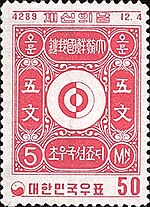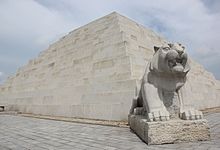Dangun
| Dangun | |
 Portrait of Dangun (by Chae Yong-sin, 19–20th century) | |
| Korean name | |
|---|---|
| Hangul | 단군왕검 |
| Hanja | |
| Revised Romanization | Dangun Wanggeom |
| McCune–Reischauer | Tan'gun Wanggŏm |
| IPA | [tan.ɡun waŋ.ɡʌm] |
Dangun or Tangun (Korean: 단군; Hanja: 檀君; [tan.ɡun]), also known as Dangun Wanggeom (단군왕검; 檀君王儉; [tan.ɡun waŋ.ɡʌm]), was the legendary founder and first king of Gojoseon, the first Korean kingdom. He founded the first kingdom around the northern part of the Korean Peninsula. He is said to be the "grandson of heaven",[1] "son of a bear",[2] and to have founded the first kingdom in 2333 BC. The earliest recorded version of the Dangun legend appears in the 13th-century Samguk yusa, which cites Korea's lost historical record, Gogi (고기; 古記; lit. 'Ancient Record') and China's Book of Wei.[3]
Koreans celebrate Dangun's founding of Gojoseon, Korea's first dynasty, on 3 October as a national holiday known as National Foundation Day (Gaecheonjeol). It is a religious anniversary started by Daejongism (대종교; 大倧教), worshipping Dangun.
Many Korean historians regard Dangun and Tengri as being etymologically identical.[4]
Myth and interpretations
[edit]| History of Korea |
|---|
 |
| Timeline |
|
|
In Korean mythology, Dangun's ancestry legend begins with his grandfather Hwanin (환인; 桓因), the "Lord of Heaven". Hwanin had a son, Hwanung, who yearned to live on the earth among the valleys and the mountains. Hwanin permitted Hwanung and 3,000 followers to descend onto Taebaeksan (written as Myohyang-san in samguk sagi, but now believed to be Paektu Mountain),[5] where Hwanung founded Sinsi (신시; 神市, "City of God"). Along with his ministers of clouds, rain and wind, he instituted laws and moral codes and taught humans various arts, medicine, and agriculture.[6] Legend attributes the development of acupuncture and moxibustion to Dangun.[7]
A tiger and a bear prayed to Hwanung that they might become human. Upon hearing their prayers, Hwanung gave them twenty cloves of garlic and a bundle of mugwort, ordering them to eat only this sacred food and remain out of the sunlight for 100 days. The tiger gave up after about twenty days and left the cave. However, the bear persevered and was transformed into a woman. The bear and the tiger are said to represent two tribes that sought the favor of the heavenly prince.[8]
The bear-woman, Ungnyeo, was grateful and made offerings to Hwanung. However, she lacked a husband, and soon became sad and prayed beneath a "divine birch" tree (신단수; 神檀樹; shindansu) to be blessed with a child. Hwanung, moved by her prayers, took her for his wife and soon she gave birth to a son named Dangun Wanggeom.[9]
Dangun ascended to the throne, built the walled city of Asadal situated near Pyongyang (the location is disputed), and called the kingdom Joseon—referred to today as Gojoseon so as not to be confused with the later kingdom of Joseon that was established roughly 2000 years later. He then moved his capital to Asadal on Mount Paegak or Mount Gunghol.[10]
Dangun's biography reflected the interest of the people of Dangun Joseon (Gojoseon) at the time in establishing the legitimacy of the kingship of Gojoseon and the dignity of the country. The king of Gojoseon conducted a ritual in honor of his ancestral god every year. Soon, the myth of Dangun was the political ideology of the Gojoseon period, and the ritual had a function of political assembly.
Dating
[edit]Emperor Dangun's rule is usually calculated to begin in 2333 BCE, based on the description of the Tongguk t'onggam (1485) contrary to the 40th year of the reign of the legendary Chinese Emperor Yao.[11] Other sources vary somewhat, but also put it during Yao's reign (traditional dates: 2357 BC-2256 BC). The Samguk yusa states Dangun ascended to the throne in the 50th year of Yao's reign, while Annals of the Joseon Dynasty says the first year and Tongguk t'onggam says the 25th year.[12]

Until 1961, the official South Korean era (for numbering years) was called the Dangi (단기; 檀紀), which began in 2333 BC. Followers of Daejongism considered 3 October in the Korean calendar as Gaecheonjeol.[13] This day is now a public holiday in South Korea in the Gregorian calendar called "National Foundation Day". North Korea dates Dangun's founding of Gojoseon to the early 30th century BC.[14]
15 March in the year 4340 of the Dangun Era is called "Royal Day Festival" (어천절; 御天節; Eocheonjeol), the day that the semi-legendary founder Dangun returned to the heavens.[citation needed]
Historical perception
[edit]Dangun began to attract attention during the late Goryeo dynasty, when Koreans fought wars against the Mongolian Yuan dynasty. During the Joseon period they were worshiped as the ancestors of the nation. In the Joseon dynasty, a shrine dedicated to Dangun of Gojoseon and King Chumo of Goguryeo was built in Pyongyang, and the Samseongdang (삼성당; 三聖堂), dedicated to the gods of Hwanin, Hwanung, and Dangun, was built.
In Korea at the end of the 19th century, it was greatly emphasized to highlight the resistance of the Joseon people against Imperialist invasion, and it developed into a religion, Dangunkyo (단군교; 檀君敎). Dangun, who emerged as the central figure of nationalism, played a large role in the spiritual foundation of the independence movement during the Japanese colonial period. In addition, the history of the Dangun era was compiled by followers of Daejongism, such as 'Daedong Sagang' (대동사강) and 'Gyuwon Sahwa' (규원사화) and the independence movement, emphasizing the history of the Dangun period.
The study of Dangun in South Korea focused on the historical significance of the Gojoseon society. In South Korea, Dangun Wanggeom is regarded as the head of the Gojoseon society, with many characteristics of the role of high priest. Wanggeom has the meaning of an overlord who governs the country.
In North Korea, the Dangun and Dangun myths were previously established as the founding myth to justify the process of establishing the Gojoseon regime. However, after the excavation of the Mausoleum of Tangun in 1994, North Korea changed its position and claimed that the Dangun myth reflects historical facts and that Dangun is a real person. Also, Dangun claims that the first king of Gojoseon, founded by the Korean people, had all of his birth, founding, and tombs in Pyongyang. There is a tomb of Dangun that North Korea excavated and reconstructed near the city directly under Pyongyang.
Appearances
[edit]The earliest recorded version of the Dangun legend appears in the 13th century Samguk yusa, which cites China's Book of Wei and Korea's lost history text Gogi (고기; 古記).[15] This is the best known and most studied version, but similar versions are recorded in the Jewang Un-gi by the late Goryeo scholar Yi Seunghyu (이승휴; 李承休, 1224–1300), as well as the Eungje Siju (응제시주; 應製詩註) and Sejong Sillok (세종실록; commonly known as "Annals of the Joseon Dynasty", Sejong Jang-heon Dae-wang Shil-lok; 세종장헌대왕실록; 世宗莊憲大王實錄) of the early Joseon. Dangun is worshipped today as a deity by the followers of Cheondoism and Daejongism.[16]
In taekwondo
[edit]Dangun is the second pattern or hyeong in the International Taekwon-Do Federation form of the Korean martial art taekwondo. Students learn that the hyeong represents "the holy legendary founder of Korea in the year 2333 BC."[17]
Mausoleum of Dangun
[edit]
North Korea's leader Kim Il Sung insisted that Dangun was not merely a legend but a real historical person. As a consequence, North Korean archaeologists were compelled to locate the purported remains and grave of Dangun.[18]
According to a North Korean publication, the Mausoleum of Dangun is the alleged burial site of the legendary Dangun.[19]
See also
[edit]- Tengri
- Musok
- Daejongism
- History of Korea
- Religion in Korea
- Yellow Shamanism
- Manchu shamanism
- Shamanism in Siberia
- Turco-Mongol tradition
- Tungusic creation myth
- List of national founders
References
[edit]- ^ Melton, J. Gordon (2014). Faiths Across Time: 5,000 Years of Religious History. Vol. 1. ABC-Clio. pp. [1]. ISBN 978-1610690263.
- ^ Kang, Chae-ŏn (2006). The Land of Scholars: Two Thousand Years of Korean Confucianism. Homa & Sekey. pp. [2]. ISBN 1931907374.
- ^ 한국 브리태니커 온라인 '단군' Encyclopædia Britannica online Korea '단군 Dangun'
- ^ Kim, Sang Yil (March 1986). "Hanism: Korean Concept of Ultimacy". Ultimate Reality and Meaning. 9 (1): 17–36. doi:10.3138/uram.9.1.17. ISSN 0709-549X.
- ^ David A., Mason. "The Background and Contemporary Spiritual-Nationalist Significance of Mt. Baekdu-san and the Baekdu-daegan Range, in All of Korea". Retrieved 30 December 2024.
- ^ The Story of Dan-gun Archived 3 September 2011 at the Wayback Machine
- ^ Needham, J; Lu GD (2002). Celestial lancets: a history and rationale of acupuncture and moxa. Routledge. pp. 262. ISBN 0-7007-1458-8.
- ^ "Myth of Founding-King Dan-gun".
- ^ Tudor, Daniel (2013). Korea: The Impossible Country: The Impossible Country. Tuttle Publishing. pp. [3]. ISBN 978-1462910229.
- ^ Tudor, Daniel (2013). Korea: The Impossible Country: The Impossible Country. Tuttle Publishing. pp. [4]. ISBN 978-1462910229.
- ^ Richmond, Simon; Yu-Mei Balasingamchow (2010). Lonely Planet Korea. Lonely Planet. p. 25. ISBN 978-1742203560.
- ^ Hong, Sung-wook (2008). Naming God in Korea: The Case of Protestant Christianity. OCMS. p. 56. ISBN 978-1870345668.
- ^ Lim, SK (2011). Asia Civilizations: Ancient to 1800 AD. Asiapac Books Pte Ltd. p. 76. ISBN 978-9812295941.
- ^ KCNA
- ^ Hong, Sung-wook (2008). Naming God in Korea: The Case of Protestant Christianity. OCMS. pp. [5]. ISBN 978-1870345668.
- ^ Mason, David A. (1999). Spirit of the Mountains: Korea's San-Shin and Traditions of Mountain-worship. Hallim Publishing. pp. [6]. ISBN 1565911075.
- ^ Kemerly, Tony; Steve Snyder (2013). Taekwondo Grappling Techniques: Hone Your Competitive Edge for Mixed Martial Arts. Tuttle Publishing. pp. [7]. ISBN 978-1462909919.
- ^ Tertitskiy, Fyodor (6 June 2016). "The good things in North Korea". NK News. Retrieved 20 July 2016.
- ^ G. John, Ikenberry; Chung-in Moon (2008). The United States and Northeast Asia: debates, issues, and new order Asia in world politics. Rowman & Littlefield. pp. 204 [8]. ISBN 978-0742556393.
Further reading
[edit]- Tangun : Founder-king of Korea (Collection of Treatises) (PDF). Pyongyang: Foreign Languages Publishing House. 1994. OCLC 272459364.
